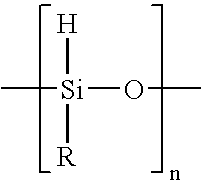Siloxane polymerization in wallboard
a technology of siloxane and wallboard, which is applied in the direction of sustainable waste treatment, ceramics, weaving, etc., can solve the problems of affecting the quality of finished products, so as to achieve the effect of dimensional stability of products, little expansion, and little cracking
- Summary
- Abstract
- Description
- Claims
- Application Information
AI Technical Summary
Benefits of technology
Problems solved by technology
Method used
Image
Examples
example 1
[0046] Two grams of BAYMAG 30 dead-burned magnesium oxide and 4 grams of Class C fly ash were added to 500 grams of stucco from each of several sources specified in Table II. These dry components were placed in a plastic bag and shaken to mix them. An emulsion was prepared by mixing 3.2 grams of BS 94 siloxane and 550 grams of water for 2.5 minutes in a high shear Silverson Mixer (Silverson Machines, East Longmeadow, Mass.). The emulsion was transferred to a 1 liter Waring blender at 7500 rpm (Waring Products, Inc., Torrington, Conn.) for 10 seconds. The slurry was then cast into a 2″×2″×2″ cube mold. After set, the cubes were unmolded and placed in an oven for drying to a constant weight at 110° F. Dried cubes were soaked in water for two hours for the water absorption test as specified in ASTM C1396, herein incorporated by reference. The weight gain during the soaking was used to calculate the water absorption.
TABLE IIStuccoDryDryWetWater%SourceDensityWeightWeightPickupAbsorptio...
example 2
[0048] Commercial scale trials where held to test the behavior of a slurry including b 12 lb / MSF siloxane, and having magnesium oxide and fly ash as indicated in Table III. The fly ash and magnesium oxide were added to the stucco prior to entering the mixer. The brand and type of calcined magnesium oxide is also shown in Table III.
[0049] Siloxane was added to the gauging water and mixed in a high shear mixer to form an emulsion. This emulsion and the dry components were combined in the stucco mixer until a homogeneous slurry was formed, and the slurry was deposited on a face paper on a conveyor. Backing paper was placed atop the slurry and the sandwich was fed to a forming roller that flattened the sandwich to a uniform ½inch (1.2 cm) thickness. When the slurry was sufficiently set to hold its shape, the continuous board was cut into 8-foot lengths.
TABLE IIITrial ConditionTrial BoardMgOMgOFlyash2 Hr.SourceAmountAmountAbsorptionBaymag 96405.3%″405.9%″404.4%″405.4%″405.8%MagChem 10...
example 3
[0051] Cubes were made according to Example 1 using Shoals stucco and 0.6 wt % BS 94 siloxane. Either Baymag 30 magnesium oxide, fly ash or both was added to the slurry as indicated in Table IV. The target water adsorption was 6%.
TABLE IVBaymag 30Fly AshWater Adsorption0.4%021.5%00.8% 24%0.4%0.8% 2.0%
[0052] When magnesium oxide and fly ash are used together, water reduction improved by an order of magnitude in the above example.
PUM
| Property | Measurement | Unit |
|---|---|---|
| Fraction | aaaaa | aaaaa |
| Fraction | aaaaa | aaaaa |
| Fraction | aaaaa | aaaaa |
Abstract
Description
Claims
Application Information
 Login to View More
Login to View More - R&D
- Intellectual Property
- Life Sciences
- Materials
- Tech Scout
- Unparalleled Data Quality
- Higher Quality Content
- 60% Fewer Hallucinations
Browse by: Latest US Patents, China's latest patents, Technical Efficacy Thesaurus, Application Domain, Technology Topic, Popular Technical Reports.
© 2025 PatSnap. All rights reserved.Legal|Privacy policy|Modern Slavery Act Transparency Statement|Sitemap|About US| Contact US: help@patsnap.com

